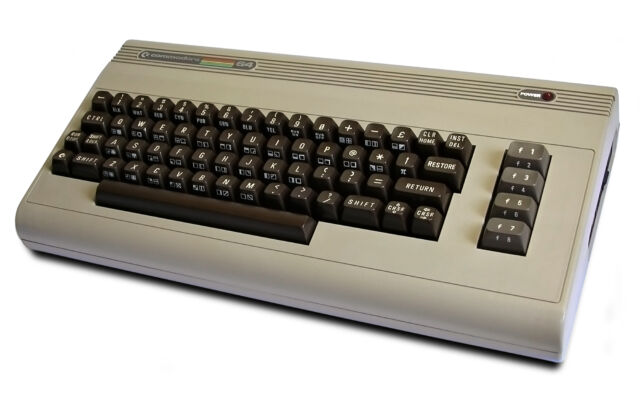Fits in nicely with old cassettes and floppy disks.
8BitDo
The keyboard uses a top mount and has an aluminum top plate.
8BitDo
The keyboard has knobs for toggling connectivity modes (left) and controlling the connected system’s volume (right).
8BitDo
There’s a magnetic compartment for storing the optional wireless dongle.
8BitDo
The Commodore 64 introduced a generation of future computer geeks to personal computing. The 8-bit system first launched in 1982 and was discontinued in 1994. During that time, it made its mark as one of the first and most influential personal computers, and many still remember the computer fondly.

Enlarge / A Commodore 64.
Gaming peripherals maker 8BitDo wants to bring that nostalgia to people’s fingertips and this week announced the Retro Mechanical Keyboard – C64 Edition. 8BitDo is careful not to use the name “Commodore” outright. But with marketing images featuring retro Commodore gear in the background, press materials saying that the keyboard was “inspired by the classics,” and certain design cues, the keyboard is clearly a tribute to the ’80s keyboard-computer.
8BitDo starts with the sort of beige that you only see on new peripherals these days if the gadgets are trying to appear old. A rainbow stripe runs horizontally and north of the function row, like on Commodore’s computer. There’s a power button with a bulb popping out of the keyboard case, ready to illuminate when it receives the signal.
The 8BitDo keyboard’s power LED.
8BitDo
Retro rainbow.
8BitDo
Like the Commodore 64, the C64 keyboard has limited keys, foregoing a number pad. The column of F-keys on the right side of the retro computer is abandoned in favor of today’s standard navigation keys. Naturally, the ports have also been updated. 8BitDo’s wireless mechanical keyboard can connect with a detachable USB-C to USB-A power cable via a 2.4 GHz wireless USB-A dongle or Bluetooth 5.0. 8BitDo claims that the keyboard’s 2000 mAh battery can endure 200 hours of use before needing a charge.
The new keyboard also reduces the bulkiness of a true vintage keyboard. It’s 6.7 inches tall and weighs 2.31 pounds. Commodore 64s were about 8 inches tall and weighed over 4 pounds.
A trimmer keyboard should help 8BitDo better appeal to its core audience of gamers. The keyboard even comes with a separate pair of large buttons and a joystick for gaming with an arcade feel. The joystick and Super Buttons, as 8BitDo calls them, are programmable, including with macros, without downloading 8BitDo’s software.

Enlarge / The keyboard comes with a joystick and mega-size buttons, just like 8BitDo’s NES-inspired keyboard.
8BitDo
The C64 doesn’t support Apple devices; it only supports Windows 10 and Android 9.0 and higher. The software for reprogramming the keyboard and setting up different profiles (which you can toggle with the heart button near the keyboard’s top edge) doesn’t officially support Apple OSes.
SA keycaps
If you really want to feel like you’re typing on an ’80s system, it’s not just about muted shades of beige; it’s about what your fingers feel. While there are some design changes that might have made the keyboard feel more authentic, some thought was clearly given to making this 2024 keyboard feel like it came out more than 30 years ago.
To start, the C64’s keycaps are made of ABS plastic with doubleshot legends. Some premium mechanical keyboards these days opt for PBT, as such keycaps typically offer better grip and resist fingerprint smudges better. But if we’re trying to be as accurate to the original C64 as possible, doubleshot ABS is the way to go.
The keycaps on the Commodore 64 were also notably spherical and contoured. 8BitDo’s design uses SA-profile keycaps, which are some of the tallest keycaps that are widely available. Some hardcore enthusiasts can tell the difference between SA keycaps and the Commodore 64’s original keycaps, but this is still a strong choice from 8BitDo, (plus the original Commodore 64 keycaps wouldn’t fit on modern mechanical switches without some modding).
>>> Read full article>>>
Copyright for syndicated content belongs to the linked Source : Ars Technica – https://arstechnica.com/?p=2013448































